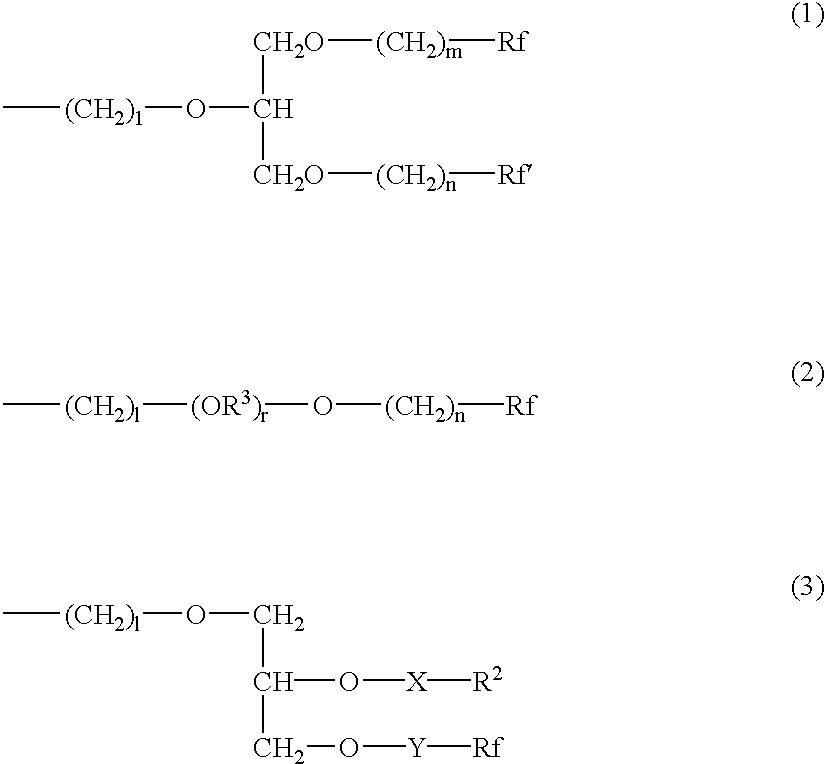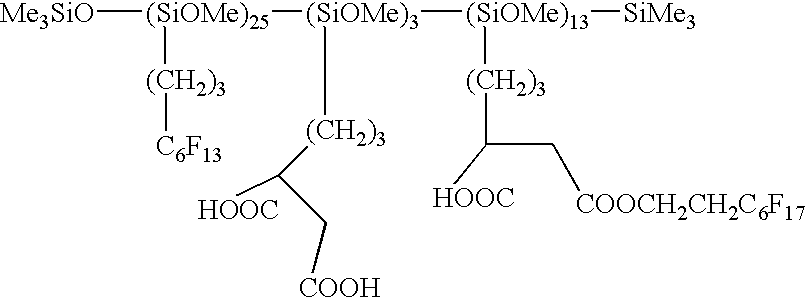Use of functionalized silicone composition for producing a hydrophobic and/or oil-repellent coating and/or impregnation with low surface energy
a technology of functionalized silicone and hydrophobic oil, which is applied in the direction of liquid repellent fibres, coatings, other chemical processes, etc., can solve the problems of low yield, low efficiency of conventional platinum-based industrial hydrosilylation catalysts (for example of the karstedt type), and relatively complex synthetic strategy
- Summary
- Abstract
- Description
- Claims
- Application Information
AI Technical Summary
Problems solved by technology
Method used
Image
Examples
example 1
Synthesis of the Malonic Allyldiester of Hexadecanol
968 g (4 mol) of hexadecanol (Aldrich), 440 g of diethyl allylmalonate (2.2 mol) and 7.04 g of butyl titanate are introduced into a 2,000 cc reactor. The reaction mass is brought to 130.degree. C. in order to remove the ethanol formed during the reaction. After reacting for 72 h, 95% of the expected ethanol has been removed (174.5 g) and the product is recovered by precipitating from methanol. NMR analysis confirms the purity of the product (cf. Example IX, EP No. 96 420 251.9). 2) Polymers Synthesis
The reaction is monitored by volumetric determination of the SiHs and the disappearance by IR of the peaks at 2,150 cm.sup.-1 corresponding to the SiH functional group and the peaks at 3,085 cm.sup.-1 and 1,645 cm.sup.-1 corresponding to the unsaturations.
example 2
101.2 g of 1,2-dimethoxyethane (Prolabo) are introduced into a 500 cc reactor and and 3.7 mg of Pt are added in the form of an organometallic complex comprising 11.2% of platinum.
The temperature is brought to 90.degree. C. and 29.64 g (0.05 mol) of the hydrocarbonaceous diester of example 1 (in the molten form, .theta.=60.degree. C.) and 88.3 g of a fluid comprising SiH assaying 2.55 mol of SiH functional groups / kg (0.225 mol of SiH functional groups) with the formula: MD.sub.50 D'.sub.50 M [M=(Me).sub.3 SiO.sub.1 / 4 - / D=(Me).sub.2 SiO.sub.2 / 4 / -D'=MeHSiO.sub.2 / 4 ] are run in simultaneously over 1 hour.
After reacting for 3 hours, IR quantitative determination indicates that the unsaturations have disappeared and 84.6 g (0.075 mol) of the perfluorinated diester of diethyl allylmalonate (in the molten form, .theta.=60.degree. C.) are run in over 30 minutes. After reacting for 16 hours, IR quantitative determination indicates that the unsaturations have disappeared and 19.7 g of 4-allyl...
example 3
13.4 g of toluene (Prolabo) are introduced into a 150 cc reactor. Heating is carried out to 90.degree. C. and 1.2 mg of Pt in the form of an organometallic complex comprising 11.2% of platinum are added.
A solution composed of 40 g of toluene (Prolabo), of 54 g (0.052 mol) of the perfluorinated diester of diethyl allylmalonate and 20 g of fluid comprising SiH of example 2 assaying 2.55 mol of SiH functional groups / kg (0.05 mol of SiH functional groups) is run in over 3 hours.
After reacting for 4 h 30, the degree of conversion of SiH units is 99.5%.
The product is recovered by precipitating from methanol and is dried under vacuum in an oven at ambient temperature for 48 h.
Material balance=91.8%.
The product obtained is as follows: ##STR10##
PUM
| Property | Measurement | Unit |
|---|---|---|
| temperature | aaaaa | aaaaa |
| temperature | aaaaa | aaaaa |
| temperature | aaaaa | aaaaa |
Abstract
Description
Claims
Application Information
 Login to View More
Login to View More - Generate Ideas
- Intellectual Property
- Life Sciences
- Materials
- Tech Scout
- Unparalleled Data Quality
- Higher Quality Content
- 60% Fewer Hallucinations
Browse by: Latest US Patents, China's latest patents, Technical Efficacy Thesaurus, Application Domain, Technology Topic, Popular Technical Reports.
© 2025 PatSnap. All rights reserved.Legal|Privacy policy|Modern Slavery Act Transparency Statement|Sitemap|About US| Contact US: help@patsnap.com



